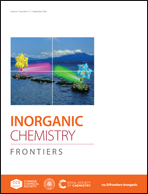Demystifying the mechanism of NMP ligands in promoting Cu-catalyzed acetylene hydrochlorination: insights from a density functional theory study†
Abstract
For acetylene hydrochlorination, as a substitute for toxic mercury catalysts, Cu-based catalysts are probably the most promising and highly active non-noble metal catalysts. Here, density functional theory (DFT) was used to reveal the mechanism for how the NMP ligand significantly promotes the activity and stability of the Cu-catalyzed acetylene hydrochlorination reaction. According to the experimental and DFT results, the high activity of the NMP coordinated Cu-based catalyst is attributed to the catalyst–ligand and substrate–ligand interactions, which stabilize the substrate-Cu(II)-ligand complex in the catalytic cycle. Moreover, the most important two stages were investigated in detail: the reduction of (i) Cuα+ to Cu0 and (ii) Cu2+ to Cu+ during the reaction process. The results demonstrate that the NMP ligand prevents high valence Cu2+ from being reduced due to the geometric distortion influence and the hydrogen bond interaction between the catalysts and ligands. Also, NMP could inhibit the carbon deposition by avoiding the formation of Cu(0) and its strong adsorption of acetylene on the surface.



 Please wait while we load your content...
Please wait while we load your content...